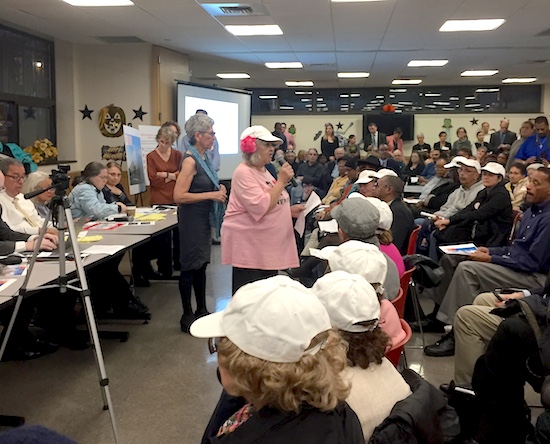
About 100 people signed up to speak at Monday night’s meeting.
By Carol Tannenhauser
It was crowded, raucous, rude, impassioned, and angry. People heckled, booed, cheered, and challenged each other, verbally and physically, at one point becoming so confrontational that someone nervously yelled, “Call security!”
In the end, that wasn’t necessary and the Community Board 7 joint-committee hearing on the affordable-housing project proposed for West 108th Street, held Monday night at Goddard Riverside with a crowd of about 200, accomplished its mandated purpose: to allow the public to have its say, on the record, about whether or not the project should move forward — and why.
Much of the opposition concerned the eventual demolition of three city-owned parking garages, holding 750 cars, representing 25% of the off-street parking in Manhattan Valley, the neighborhood where the housing would be built. Valley Lodge, a homeless shelter for seniors that the West Side Federation for Senior and Supportive Housing (WSFSSH) has operated at that location for 30 years would be expanded, and 275 units of permanent, affordable housing would be added in two phases.
“We actually spent a great deal of time and energy and, frankly, money exploring the parking situation to see if we could include parking as part of our project,” said Paul Freitag, executive director of WSFSSH. “We put an RFP out to parking operators, including the current one, and asked them how we could put parking under the building. Unfortunately, in this location, the bedrock comes almost up to the surface. We were told uniformly that the cost of excavating would be prohibitively expensive. We really tried.”
For many at the meeting, it’s a “no brainer.”
“Housing is a right! Parking is not!” one woman yelled at the audience.
Another said, “I’ve lived in this community for over 40 years and I’ve seen the dramatic erosion of affordable housing. My car is parked in one of the garages. I’m sorry at the prospect of losing my parking space. It’s affordable and very convenient. But when it comes to a choice between affordable housing and a parking garage, it is a no-brainer. And WSFSSH has a long and stellar history. There is no better organization to be spearheading this project.”
There was no argument with WSFSSH, a clearly respected Upper West Side nonprofit that has been providing housing and services, primarily for older New Yorkers, for 40 years. Person after person, many wearing white baseball caps proclaiming “I Support WSFSSH at West 108,” spoke on behalf of the agency. Among them were religious and other nonprofit leaders, as well as people who have been helped by their services.
“WSFSSH saved my life,” a man said. “How can you compare a car with a life? Are you crazy? People complain about the homeless in the streets, and then, when we want to do something about it, they say, ‘Not in my neighborhood!’ Make up your mind. Are you human or inhuman? What are we supposed to do, disappear from the Earth?”
Opponents brought up issues of fairness, the impact on the environment, and quality-of-life issues.
“Ninety-sixth Street and above is a segregated community,” another man declared. “No one talks about it. When you go north of 96th Street, the environment changes completely.”
Manhattan Valley, which falls between West 96th and 110th Streets, from Broadway to Central Park West, has about half of the supportive housing on the Upper West Side.
“Collegiate School was supposed to build affordable, low-income housing at West 61st Street,” the man contended. “However, they reneged on the deal. They had an agreement with CB7, but, mysteriously, they chose not to build affordable housing at 61st Street. They decided to send the money to 108th.”
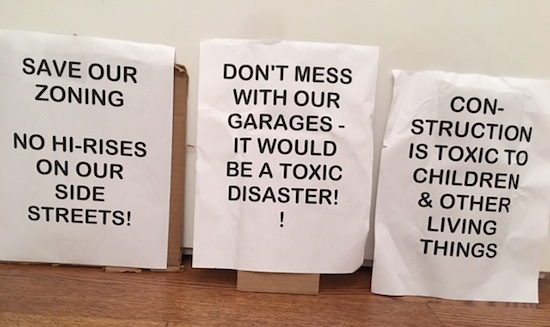
Signs made by opponents of the project.
“My issue isn’t with WSFSSH or affordable housing,” a woman said. “My issue is with the indecent politics of New York City.”
“Amen!” someone else shouted.
“I want to appeal to the community board in regard to the indecent politics at play in this particular project. When we met with WSFSSH in the beginning, the building wasn’t so tall, and it was just about Valley Lodge. They go to HPD [the Housing Preservation and Development agency] and HPD says ‘Why don’t you take the whole block and build higher?’ And HPD gets to sign off on itself for a project that violates zoning and changes the rules. I don’t understand that. My appeal is, please take a hard look at the integrity of some of the decisions.”
Michael Hiller, an attorney for Save Manhattan Valley, a nonprofit group fighting the development, stressed potentially negative environmental impacts.
“We represent more than 3,000 people who oppose the development in Manhattan Valley…it is dangerously harmful to the community.”
Hiller said he had hired an “independent” environmental consultant who concluded that “there are serious environmental impacts which could crush this community…poly corrugated biphynels, asbestos, lead paint, and other cancer-causing agents that could be released in this community unless this project is changed or withdrawn. There are more than 3,000 alternate sites that are available for this project and we will encourage the Community Board to reject this project and re-site it to another location.”
Hiller also spoke of “shadow impacts” on an adjacent playground and school sports field across the street.
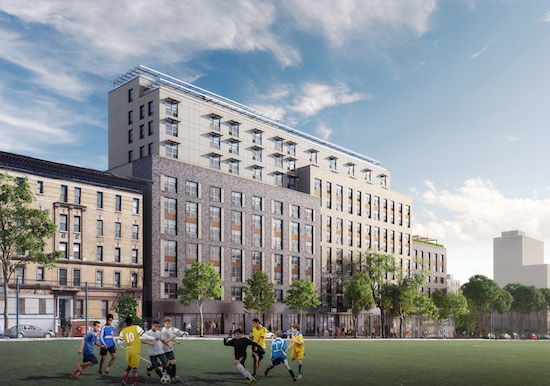
A rendering of the project via WSFSSH.
“I’m thinking to myself, are we really still doing this?” a woman responded. “We’ve been fighting for affordable housing since the 70s. Environmental issues have nothing to do with this. If there are environmental issues they will be dealt with so people can live safely. And to say, ‘Save Manhattan Valley,’ it was WSFSSH, along with others, that started to make this neighborhood what it is!”
But will it stay that way?
“I’m not here to oppose any of the impassioned pleas about affordable housing,” a man said. “I am here to support reasonable and responsible balance in urban planning. When you take away a resource that supports those who have the means, replacing it with those who don’t have the means, you drive the neighborhood down, not up.”
“I do not understand why everybody is talking about either/or,” a woman said. “I have never met anybody who was against affordable housing. What I don’t understand is why they don’t consider a multilevel parking garage as part of this project, because 750 cars riding around, fighting for parking spaces…there needs to be a solution that works for all of us.”
“It’s unfair,” a man said. “We’re middle class. Do we want to see just very rich people and low-income housing? I work for a living. I’m a teacher. I used to go downtown. Now I have to take my car to work. I’m not going to come home and drive around for an hour looking for a parking space. If this goes through as is, I’m out of here — and I’m taking my taxes with me.”
In all, 100 people signed up to speak — and this was just the first of two CB7 joint-committee meetings on this topic. The next will take place on November 20th. Someone asked that a bigger room be used, suggesting that this issue is far from resolved.
Photo by Carol Tannenhauser.



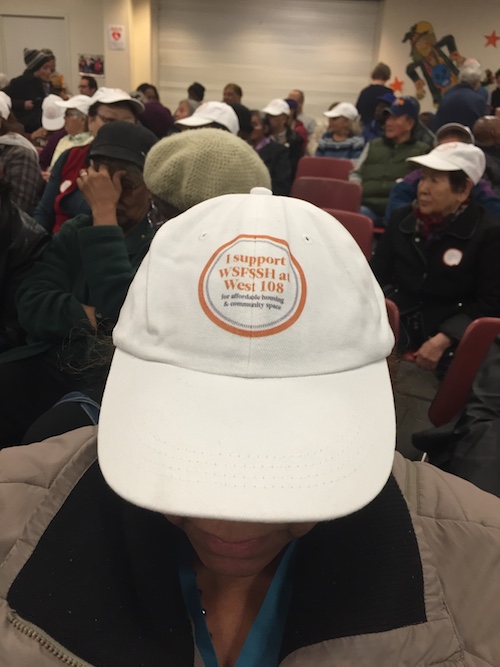
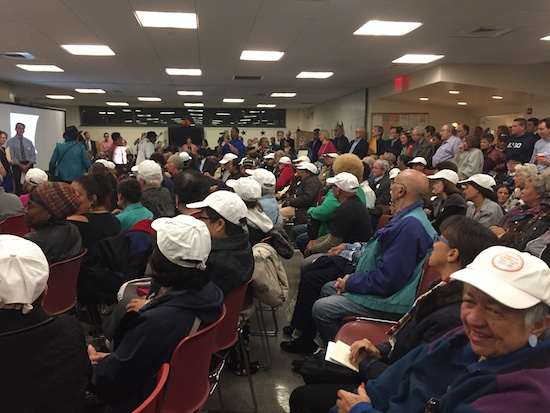




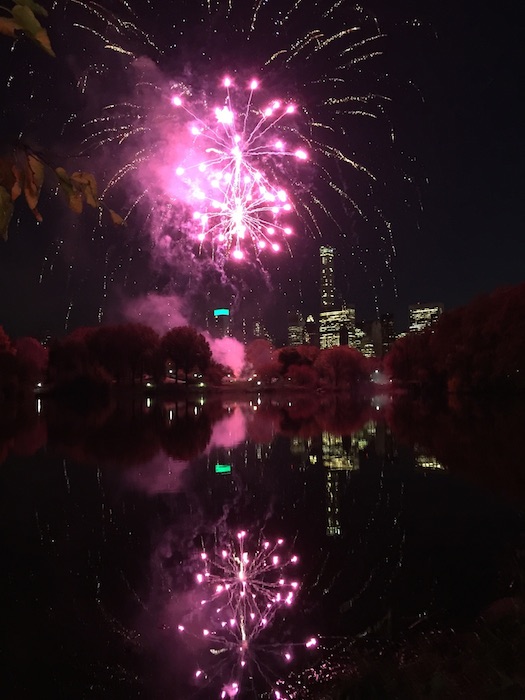
For decades NYC has had rent control and rent stabilization on apartments that are attractive to families and those not in a position to afford expensive condos and coops. That rent regulation was adopted at the end of WW II for the purpose of enabling the influx of veterans to find affordable housing on their return, and it was not supposed to last in perpetuity, yet that is what has happened because once a benefit is granted, it is virtually impossible for the politicians to eliminate it. An unintended consequence has been that landlords stopped building regular apartments because govt intervention and price controls deprived them of the return on their investment that can be achieved by placing their time, effort and capital into other projects. So, lo and behold, the regulatory environment choked off new investment and the situation deteriorated. No surprise there. Instead of fixing the mess that these regulations created, the politicians pander to the people who want to keep their benefits by doubling down. The reality is that there cannot be affordable housing until the market delivers it, which can only happen when the developers are allowed to choose to build, which will increase the supply to the point that rental prices drop in the marketplace. Absent that happening, this problem will persist and the govt does not have the dollars to replace what the market does not provide. The collapsed USSR experienced it, Venezuela is experiencing it now, and NYC has its own mini version in its housing market.
Broadly, you’re correct of course.
This case seems to be a bit of an exception though, for a couple reasons.
1) The choice here appears to be between expanding housing (albeit “affordable housing”) or doing nothing. Given that choice, I’d argue for expanding the housing base, even if it’s not the reasonable, market rate housing New York needs so much. That’s assuming the new apartments aren’t a governmental money pit, which is perhaps naive of me.
2) The intended residents seem to be in genuine need of affordable housing. They’re not just lottery winners who get a societally subsidized apartment because they’re lucky. You can reasonably ask why low income seniors should be subsidized to live in some of the most desirable real estate in the world instead of, say, Orlando, but that’s a separate question.
I think that ideally, you’d sell the lot to developers at market rate and use the proceeds to buy twice the amount of subsidized senior housing in a less expensive area. That rather straightforward arbitrage would expand the tax base of New York and provide affordable housing for a lot more seniors. A win-win. But that options doesn’t appear to be on the table.
“My issue isn’t with WSFSSH or affordable housing,” a woman said. “My issue is with the indecent politics of New York City.”
This is the point I’d like to make as well.
Regardless of how you feel about this specific project, don’t you think we deserve a better process?
As it is now, the city determines a desired result, and works backwards to make sure that any clear issues or problems with a project are either ignored or sidestepped.
Time and time again, the so-called “community based review” processes outlined in the CEQR technical manual serve to merely disclose the adverse impacts of a project, rather than to truly mitigate or honestly address them.
No one is against affordable housing, that’s why the Mayor’s office and HPD can sidestep normal regulations and/or requirements to build the way they choose ignoring planning and zoning considerations they themselves claim as a justification to build in the 1st place.
I know my position isn’t a popular one, but we deserve a city government that thinks about how all the pieces fit together not just in 5 or 10 years down the road, but 20, 30 and beyond.
Saying your self-interest should be paramount is hardly a reasoned argument. Politics should be decided by power, ie., voting, not phony moral posturing. Idiotic to think what matters to you personally is somehow more important than what matters to the other guy. Nonetheless, where is the god-given right to convenient cheap parking?
I worked for the most reputable and compassionate housing/human service organization, WSFSSH for greater than 12 years and know that they have the best interest of both the neighborhood and the people that need housing as their primary concern. Where is your conscience and selflessness, that those of you who live in Manhatten Valley could ever trade the lives of homeless people to obtain affordable housing for parking space? I am shocked!
I agree: “there needs to be a solution that works for all of us.” Most old-timers in this neighborhood support affordable housing and community services. But middle class people sometimes need their cars for work or eldercare. This includes teachers, musicians, social workers, and other non-wealthy professionals, many of whom have lived here for years. What are they suppposed to do?
This is an issue that was brought up at a condo owners meeting in my building this year–clearly a class issue–UWS residents who have been UWS residents for more than 30 years (who may live in rent controlled apartments, or bought their apartments before one has to be a millionaire to live here) Vs. newbie UWS residents who came to the UWS because it has a Whole Foods and they can ride a Citibike in Central Park easily. Those who are moving in could not care less about affordable housing for others, nor do they want those types in the neighborhood. If one cannot afford to live here at market rate, then they should be moved as far uptown as possible. That’s the reality. The UWS/Manhattan Valley IS NO LONGER A PLACE FOR EVERYONE–MANHATTAN IS NO LONGER A PLACD FLR EVERYONE. if you don’t have the money, you don’t belong.
Yup.
build 700 parking spots underground give displaced 700 first right to come back when new garage is completed they should get the same discount they are getting now
“poly corrugated biphynels”?
Chlorine is the main reason PCBs are a problem. Plus when Monsanto found that Aroclor was contaminating the entire planet they responded by making even more.
PCBs were used in caulk, paint and sealant because chlorine compounds last a very long time which saved on maintenance As they disperse they get into the food chain and build up in fat until they cause cancer.
<>